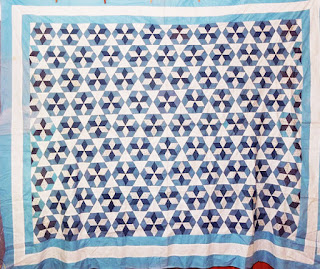I love living in the past. I know how things turn out.
A century ago things were happening. James Joyce's
Ulysses & T.S. Eliot's
The Wasteland were published. Yankee Stadium &
The Readers' Digest started
. Betty White, Jack Kerouac and Doris Day were born and Marcel Proust died. Radio was taking over in communications and I can
imagine my 12- year-old father working on his hand-built crystal set.
Cafe du Dome in Paris
Modernism was centered in Europe; the stagnant past in the U.S. where Prohibition reigned and Sinclair Lewis published
Babbitt, satirizing small-town values.
From our perspective quilt style a hundred years ago looks stuck in the stagnant past too.
Although wool, embroidered quilts like this one might have
seemed fashionable and forward thinking at the time.
Tennessee Project & the Quilt Index, name quilt dated 1922.
Rocky Mountain Quilt Museum, dated 1897-1922
American Museum of Folk Art
Crazy quilts were by then a 40-year old fashion, assembled of wools. Silk scarcity due to world politics meant these once elegant parlor throws were now the Babbitts of the bedding world.
Name quilt from 1922 in Laura Fisher's inventory
The idea of embroidering names remained popular.
Redwork extravaganza with many names, probably a fundraiser---
from the West Virginia project and the Quilt Index.
From Clifton, Tennessee and the Arizona project.
Redwork, outline embroidery, also remained in fashion, another
40-year-old fad.
In other words---things in the quilt world were dull.
And dated quilts from that year are scarce.
Four Patch, 1922, signed Dorothy Biddle
Woven patterns are easier than prints for mills to produce.
Attitudes towards making quilts in the early 1920s were undoubtedly influenced by changes in the textile industries due to the Great War. Germany had held the patents on many reliable dyes for printing cotton and these were awarded to the Allies after their victory.
1922 Minneapolis Star
Patriotic quilt from Stella Rubin's inventory. She writes it
was once dated 1922 in the bottom border.
Is that Betsy Ross showing a flag to Washington?
Looks like the maker used a fast blue and Turkey red as that is
just the kind of blue to fade from light at the time.
Although war had been over for three years the dated quilts show us that the available fabrics continued limited and problematic, due to what we'd call supply chain issues.
Too much "patient labor going for naught."
Applique from Bammie, 1922
The green is almost gone.
Greens were among the worst, fading to tan or
completely disappearing.
This quilt in a fence rail set by or for E.C. Peter shows the variable fastness in the cottons of the day.
Indigoes & double pinks held up.
Patterns weren't innovative either
With old classics the common look.
Although dated 1922 this quilt's prints look pre-war
when innovative dyes were plentiful.
"Made When 14
Year Old M.P.
1922"
Change can be glimpsed, here in the form of
a lilac among the darks.
Colorfast solids in pastels would be the new look after
1925 and revive quiltmaking.
Harriet's top has some light fading in the solid blues.
Alphabet Quilt from Julie Silber's Inventory
Quilters had plenty of patterns to choose from.
The Ladies Art Company sold hundreds of different patterns
through the mail.
Ruby Short McKim had published her first embroidered series in 1916.
The Bedtime Quilt illustrated Thornton Wilder's stories with geometrically-inspired animal abstractions, twenty "Quaddie Quilties," she called them, a taste of modernism.
Marie Webster had been calling for a new look of pastels for over
a decade. But without reliable cottons, her call wasn't answered until the late 1920s.
International Quilt Museum
Elizabeth Miller, probably Elkhart, Indiana
1922 in the quilting.
Meanwhile out in the central midlands, Amish quiltmakers were doing everything the Modernists advocated, creating striking quilts from their cotton, rayon and wool clothing scrap solids.
1922, Ohio Amish, initialed ALM
What a contrast to mainstream style.







.jpg)


.jpg)


















































